Olympic Science
We're going for gold on this week's Olympian Naked Scientists, by discovering the sporty science of performance enhancement. We find out how drugs can help boost an athlete's performance, and how the testing labs are hot on their heels! We also explore how altitude training and hi-tech trainers can power athletes past their personal bests. Plus, a stem cell cure for muscular dystrophy, flies with flu and how a rubber Anaconda could generate energy from waves. And in Kitchen Science, we find out how to get the biggest bounce from two balls!
In this episode

Fly Flu Clue to Combating Virus
Scientists have modified an influenza virus so that it can infect fruit flies, enabling them to identify over 100 new ways to fight flu in future.
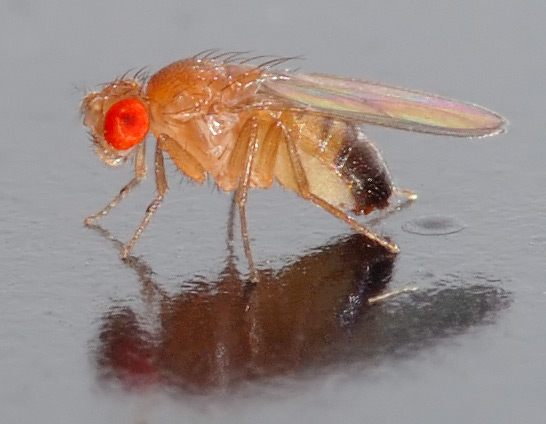 Writing in this weeks Nature, Howard Hughes Medical Institute researcher Paul Ahlquist and his colleagues describe how, by replacing the outer coat of the flu virus with proteins from a different virus that can infect fly cells, they were able to produce a form of fly flu. The team infected fly cells with this viral variant and then used a technique called RNA interference to selectively switch off each of the fly cells' 13,000 genes, one at a time, to identify those which are essential for the virus to grow. The analysis flushed out over 100 cellular genes, which have direct equivalents in mammalian cells like our own, that the virus depends upon for growth.
Writing in this weeks Nature, Howard Hughes Medical Institute researcher Paul Ahlquist and his colleagues describe how, by replacing the outer coat of the flu virus with proteins from a different virus that can infect fly cells, they were able to produce a form of fly flu. The team infected fly cells with this viral variant and then used a technique called RNA interference to selectively switch off each of the fly cells' 13,000 genes, one at a time, to identify those which are essential for the virus to grow. The analysis flushed out over 100 cellular genes, which have direct equivalents in mammalian cells like our own, that the virus depends upon for growth.
To confirm that the results would be relevant to normal strains of flu the team then tested the ability of natural strains to infect mammalian cells lacking three of the genes uncovered by the fly cell tests. They found that suppressing the function of any of the three genes, known as ATP6V0D1, COX6A1 and NXF1, prevented flu viruses, including the pandemic contender H5N1, from replicating, suggesting that the 100 genes they've identified are likely to highlight many novel therapeutic strategies for swatting the flu in future.
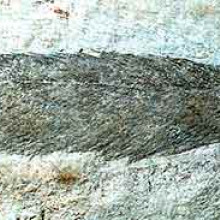
Fossilised Feathers Show Their True Colours
Over the years there have been hundreds of films and thousands of pictures made of dinosaurs, where scientists have carefully pieced together their shape and lifestyle. One critical piece of information for painting an accurate picture has been missing however - the colour.
Colours in mammals and most animals are produced by pigment molecules which don't survive the fossilisation process. However Jakob Vintner and colleagues from Yale University may have found a way of filling in the gaps for at least some dinosaurs.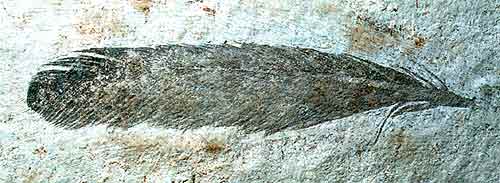
They have been studying fossilised feathers from birds that lived over 70 million years ago in what is now Brazil. They noticed that there were bands of small lumps of carbon running across the feathers. Up until now these were thought to be the remnants of feather eating bacteria, but Vintner thinks they are actually fossilised melanosomes - small lumps within the feather which contain the dark pigment eumelanin which is related to the pigment in your skin cells which give you a sun tan.
This pigment is known to inhibit the growth of bacteria and the parts of the feather with lots of the lumps seem to be better preserved than the areas with fewer.
In modern feathers the shape and distribution of these melanosomes give the colour of the feather, so if enough of them are preserved one should be able to tell what colour the feather was before it was fossilised. Birds are dinosaurs' closest living relatives, and several dinosaur feathers have been preserved, so there is every chance we could be able to tell their colour from any melanosomes preserved in them.

Stem cells rescue muscular dystrophy in mice
Scientists have shown that satellite cells, a form of muscle stem cell, can be used to repair muscles affected by muscular dystrophy.
 Working with mice and writing in the journal Cell, Harvard researcher Amy Wagers and here colleagues used chemical markers to identify a sub-population of adult muscle cells called satellite cells, some of which behave like muscle stem cells. To explore whether they could be used to repair diseased muscles, the satellite cells were labelled with a glowing green protein and injected into the muscles of mice carrying a mutation in their dystrophin genes, giving them the rodent equivalent of muscular dystropy.
Working with mice and writing in the journal Cell, Harvard researcher Amy Wagers and here colleagues used chemical markers to identify a sub-population of adult muscle cells called satellite cells, some of which behave like muscle stem cells. To explore whether they could be used to repair diseased muscles, the satellite cells were labelled with a glowing green protein and injected into the muscles of mice carrying a mutation in their dystrophin genes, giving them the rodent equivalent of muscular dystropy.
In humans this disease is characterised by the progressive destruction of muscle leaving sufferers weakened and eventually almost immobile. Amongst the mice, when their muscles were examined four weeks after the injections, the team found that the stem cells had turned into new muscle and replaced up to 94% of the original muscle fibres. This repair of the muscle was also matched by an almost six-fold increase in muscle strength to near-normal levels.
The trick works because skeletal muscles form what is known as a syncitium; this is where many muscle cells join together to form what is effectively one giant cell containing many muscle fibres. As a result, when the stem cells merge with the syncitium, they bring with them a healthy copy of the dystrophin gene, which enables the rest of the muscle to function much better.
Although the team are not suggesting that this is the cure for muscular dystrophy at this stage, what they have shown is that there are cells that can be used to effectively repair adult muscle, which might be useful for a host of different diseases.
"Taken together, these data indicate that skeletal muscle precursors [the satellite cells] act as renewable, transplantable stem cells for adult skeletal muscle," says Wagers.
A Window on Solar Power
Solar cells are expensive and difficult to produce, as they have to be made in a computer chip plant, so you want to maximise the amount of energy you can get out of each one. One way is to concentrate the light onto a cell using relatively cheap mirrors, or lenses. This means that several times more sunlight will fall on the solar cell so you can get more power out for your money. However, the more you concentrate the light using lenses or mirrors, the more accurately you have to point them at the sun, meaning that these systems need expensive and high maintenance mechanical systems. They also need costly cooling systems as they tend to waste a lot of energy as heat.![]()
Now Michael Currie and colleagues from the Massachusetts Institute of Technology (MIT) have developed a system that will concentrate light whatever direction it is coming from. They have taken a sheet of glass and covered it with a dye which absorbs light at one wavelength and then re-emits it at a slightly longer wavelength. This re-emitted light is going in random directions and most of it gets trapped within the glass sheet by a process known as total internal reflection. You could do something similar to this by adding some dirt to the surface of the glass. This would scatter the light and some would get trapped in the glass but the dirt would also scatter the light in all other directions. The MIT team's dye is specially designed not to absorb the light which it has emitted, meaning that a huge amount of light is trapped in the sheet of glass, and you just put your solar cells around the outside. Each cell produces about 10 times the amount of electricity they would do normally.
Another advantage is that you can pick the wavelength of light that your dye is producing to be the optimum wavelength for the solar cell to absorb. This means that much less energy is wasted as heat in the solar cell so it doesn't overheat so easily, reducing the need for expensive coolants.
This system converts about 6.8% of the sun's energy which isn't great, but it should be much cheaper to make and you could use it wherever you have tinted windows in a building, so skyscrapers could generate electricity rather than just using vast amounts of it.

12:17 - Anaconda Advances Wave Power
Anaconda Advances Wave Power
with Professor Grant Hearn, University of Southampton
Could an Anaconda be the best way to extract power from waves? Possibly not the snake itself, but it's namesake - a rubber tube capable of harvesting wave power...
Chris - Scientists have been exploring how they can use a giant rubber tube which has been called the Anaconda to generate electricity from the sea. Professor Grant Hearn is from the University of Southampton. Hello, Grant.
Grant - Hey.
Chris - Welcome to the Naked Scientists. What actually is your device?
Grant - The device was really invented by Francis Farley and Rod Rainey. Essentially it's a long rubber tube and it's closed off at one end and moored. At the other end you have a power take-off system. Essentially you keep the rubber tube close to the free surface. It's actually facing the on-coming wave. It's like it's at right-angles to the wave-front. As the waves come past the tube then they set off what is called a bulge wave inside the tube. As this bulge wave travels along the tube it gradually gathers more and more energy. One power take-off system we've tried is that as the wave travels along the tube essentially you can convert that energy into potential energy by allowing the water, which is being pumped to go through a valve system, and you generate a high pressure level. Then, you have a low level and you pass the water from one to the other through a turbine. Hopefully you can take the energy out of the bulge wave.
Chris - How much energy do you think you could make this way?
Grant - What they're thinking about is devices which will generate of the order on average one megawatt which may have a peak of three megawatts and an average over a year of one megawatt. If you assume that you have essentially half a kilowatt per person then that's one device that will provide energy for around 2000 homes.
Chris - Would you just have one tube in isolation or would you have rafts of these out at sea somewhere?
Grant - You would probably have a farm and at the moment what we're trying to do is understand how best to operate the tube in terms of things such as the pressure in it. The question would be, would you have tubes which are all identical or would you have tubes with different properties? If you put a tube with a different pressure in then you can take energy from a different wave frequency. So what you might then do is use a range of devices such that they're all taking power from a mixed sea state.
Dave - There's been lots of other ideas of getting energy out of waves. What's the advantage of the Anaconda over them?
Grant - If we look back in the mid 70s-early 80s most of them were mechanical devices. Salter's Duck was essentially a set of segmented sections which rotated around the cylinder and you essentially used the relative pitch of the ducks as they're called and the back spine to actually take the energy out. Cockerell Rafts were simply using the relative motion of the rigid structure. You have to have squash plates. Then you have things like oscillating water columns. In this case the only movable part is the rubber so you're actually using the stored elastic energy in the walls of the tube to actually convert the energy external into the energy which flows internally.
Chris - So it should be a lot more robust. Finally, what stage of development is this at and when can we see it in the North Sea?
Grant - I can't answer when it will be. Rod Rainey and Francis think that once we've finished the work it'll be possibly five years. At the moment myself, with John Chaplain, are entering a two year research programme sponsored by the Engineering and Physical Sciences Research Council in the UK. There we're doing both experiments at different scales and we're also developing mathematical models because the difficulty with this structure is that we know the physical boundary conditions but we can't actually put numbers on them. We have an interesting mathematical problem which is: how do you solve the problem and determine the boundary conditions at the same time?
What's the difference between petrol and diesel?
The answer to this is it's a totally different fuel source. The fuels totally differ in the way in which they behave inside the engine. Petrol engines have spark plugs and diesel engines don't. That's the simplest difference. In a petrol engine what happens is you have the piston going down in the cylinder. It pulls in some air and at the same time some fuel is added - sprayed in if you have an injection engine, or just drawn in with the air if you have a normally aspirated engine. The next thing that happens is that the piston goes up again and it compresses the mixture of petrol and air. This makes it a bit warmer because when you compress things they do heat up but it doesn't make it hot enough to ignite the petrol. Just before the piston gets to the top of the cylinder the spark plug kicks in, ignites a spark which ignites the fuel-air mixture. This burns very fast and this turns a liquid into a gas which takes up many, many times more space. This increase in volume inside the cylinder drives the piston back down inside the cylinder creating power. That's the power stroke. On the way up again the exhaust valves open and you blow the exhaust out. That's how a petrol engine works.
With a diesel engine the difference there is that you're entirely depending on the compression of the engine to make the explosion happen. What happens is the piston goes down. If you've got a normal, old fashioned diesel engine like they used to have on tractors and things this just drew in a cylinder full of air above the piston: a bit like you pulling on a syringe and filling a syringe with air. The next thing that happens is that the piston would go up and as the piston goes up it compresses the air that it's drawn in. If you've got a turbocharger on your engine actually what happens is it forces a bit more air into the cylinder under pressure. You have more air than you would normally have in the cylinder. As the cylinder comes up it compresses all of the air and when you compress air (just like putting your thumb over the end of a bicycle pump) it gets very, very hot. The heat is hundreds of degrees Celsius and just at the top of the piston compressing the air, right at the top of the cylinder, the fuel pump turns on and it sprays a fine mist of diesel fuel into this superheated air right at the top of the cylinder. This mist of diesel immediately starts to burn and just like the petrol engine it produces enormous amounts of gas. This expands very rapidly and that's what produces the power stroke. No spark plugs in a diesel engine. That's basically, in a nut shell, the difference.
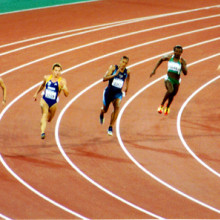
23:38 - Performance Enhancing Drugs
Performance Enhancing Drugs
with Professor Chris Cooper, University of Essex
We've seen the news stories in previous Olympic tournaments where athletes have been caught using performance enhancing drugs, such as steroids, to increase their chances of winning their event. But how much of a boost is this really giving them? We've got Dr Chris Cooper from the University of Essex with us now to tell us more.
Chris - What sorts of things to people jam into themselves in order to boost performance?
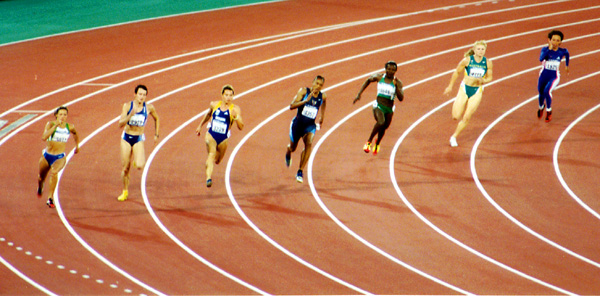
Chris C - All sorts of things. If you look at what Dwain Chambers, the current hot topic - he was taking at least seven or eight different compounds. He was taking insulin which diabetics take. He was taking testosterone, he was taking this thing called The Clear which is this magic compound developed in San Francisco to not be detected by the drugs testing agencies. He was taking thyroid hormone precursors. They take all sorts of things, some of which work and some of which may or may not work.
Chris - So if I wanted to performance enhance myself what agents would work in me?
Chris C - If you're unfit lots of things will work actually. The difficulty is if you're the super elite athlete. There are three general classes of performance enhancing drugs. There's anabolic steroids that you've probably heard of, the things that build up your muscle mass. There's the things that boost your aerobic sports so the steroids help you for strength events. The compounds that help you in aerobic sports increase the amount of oxygen you can deliver: basically increase the number of red blood cells in your body. Then there's the stimulants, things like amphetamines, cocaine, modafinil and those are a bit less clear whether they work or not.
Chris - Do you think they're more of a psychological effect because a lot of people say that a lot of winning a race is 90% psychology, don't they?
Chris C - Yeah, they are a psychological effect. Psychology is a branch of biochemistry, I'm a biochemist so they're neuropsychology. Yes, whether the drug is directly working on the brain or the athlete actually thinks they're getting an edge is an interesting question.
Chris - You think it might give them a sort of psychological angle because they feel more confident. Winners win races, don't they? There's this sort of winning streak phenomenon where people feel a confidence boost when they win once and this makes them win again.
Chris C - Sure. There's clearly examples of people being given placebos. Even in the Tour de France which is sort of the drug cocktail par excellence some of the people have said I didn't want to give him this super cocktail of stimulants and they gave him a sugar solution and he won the race. It's a combination of things really.
Chris - Looking at the agents that you can put into your body, at the biochemical level how do they actually work?
Chris C - There's been a lot of work on this recently. It's an ongoing area. The steroids, the anabolic steroids, it seems that they work by increasing you ability to improve your muscle mass after you've don't the exercise. It used to be thought they let you exercise longer and harder when you're doing your weights. Now it's thought that they mostly work on the remodelling after the exercise. That's probably how the steroids work. The compounds that increase your oxygen capacity work by increasing your amount of erithropoetin. This is what's called EPO. That controls your number of red blood cells so you just basically increase your number of red blood cells.
Chris - If you go and do what some people used to do which is run up a mountain so that you have altitude training on your side, how does that work? Is that the same phenomenon?
Chris C - Yeah, the key is not to run up a mountain. It is to go up the mountain and don't run there. You go to the mountain and when you're there your body adapts to having lower oxygen because there's less oxygen up a mountain. It makes more red blood cells. The problem with that is you can't train so well up the mountain so the current idea is to live high, train low. You go up the mountain on the cable car, leave it there and come down to the bottom for your training.
Chris - I did read somewhere someone had bought the equivalent of an oxygen tent for their bed so they could simulate oxygen levels at say, halfway up Everest for sleeping. Then they would get out of their bed during the day and exercise at sea level. This was supposed to do the same thing as going up a mountain.
Chris C - Yeah. They're very common, easily bought, not that expensive and not illegal. In the days of East Germany they used to have whole gymnasiums that were at low oxygen where the athletes just lived.
Chris - How can science also help athletes to do things in a legitimate way?
Chris C - At the University we do a number of things trying to mimic the effects that the drug might have. There are things like trying to hyperventilate before you exercise which changes your blood pH and means you can run 400m better. That's a sort of extreme version which is quite difficult. Other things to get you stimulated as equivalent of taking stimulants so you should try to train to have the same chemical effect. Then there are legal drugs that you could add.
Chris - Tell us a bit more about that. If I was to start training now what would be a good regimen for me and what sorts of equipment could I use to make sure I was effectively training the most efficiently?
Chris C - That would just depend completely on what sport you were going to do. If you were going to be a Paula Radcliffe or you were going to be Linford Christie. What you would do would depend completely on that. If you were doing a power event you would be in the gym most of the time especially in the off-season in the Winter. If you were doing the long-distance event you would be running long distances. Then of course you would have the nutrition team and the sports science team there working as well.
Mrinal Shah, New York - I wanted to know if there are any naturally derived (or if there are only synthetic) steroids. Also, if there are any natural steroids would it be possible for an athlete to get them in his daily diet? Would that disqualify him from any sporting events?
Chris C - That's a really interesting question. There are natural steroids. Testosterone is a natural steroid and obviously men have more of that than women do. It's illegal to take testosterone because it's not part of your normal diet. You can't get a diet equivalent to fail a drugs test. It's difficult to take a steroid in any normal diet to have an effect because they don't work orally. You have to inject the, Then it's obvious you're doing the cheating. Where it's a more grey area is in some of the metabolites the body makes from these artificial compounds which are also illegal because the agencies say that means you've taken the metabolites. There's a concern that if you exercise very hard on certain diets you might make small amounts of these metabolites naturally. Then it's a question of what level the drug company sets those out. It's difficult to take the natural compound to fail a drugs test. The bodies make it that way. They don't want to fail people for that.
Mario - What's the fastest a human could run, theoretically. What's the fastest a human could sprint at with the aid of all the latest blood and drug enhancements?
Chris C - The cynical answer is to say we know that because we have Tim Montgomery as an example of somebody but then he'd been beaten by Usain Bolt. I think it's quite a difficult question to answer. The world record now is 9.72 [men's 100m] and no evidence that's been done illegally. You can sort of extrapolate form that where you might get. I think increasingly we're going to see genetic anomalies, people who've got a genetic aberration that makes them perform better and that's going to be what makes the difference. A classic example was a Finnish cross-country skier who had a naturally active EPO system. He made in his body large amounts of red blood cells because he had a gene defect. It wasn't a defect, of course. I think you'll see these step changes by people who happened to have had a mutation. It's difficult to therefore extrapolate.
Chris - In this week's British Medical Journal there's an editorial by Dominic Wells who's at Imperial College. He's saying we're all worried about drugs and things but how long is it going to be before people will start doping themselves with genes? We know that certain genes definitely can enhance performance. How long will it be before people can come up with ways to switch on or add genes to their muscles to make them more genetically fit, if you like?
Chris C - I'm sure people are thinking about this. If you read a scientific paper and say that can help you in sport - and people who publish these papers which are all done for medical reasons suddenly get hoards of people, usually body builders saying how can I do this? It's difficult but it's surprising that just changing one gene or up-regulating one gene seems to have an effect on human performance. I was surprised but certainly if any of you have gone YouTube-ing you can see this picture of this mouse that's had one extra gene put into its muscle and it's running on the treadmill. It's going forever and ever like a sort of Duracell® mouse. I think it's clear that the World Anti-Doping Agency have conferences trying to test for this. I think it's going to be difficult, I think it will be hard to do it because we can't even do it in medicine yet.
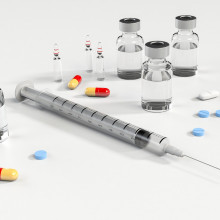
Are there any natural steroids?
We put this question to Professor Chris Cooper:
That's a really interesting question. There are natural steroids. Testosterone is a natural steroid and obviously men have more of that than women do.
It's illegal to take testosterone because it's not part of your normal diet. You can't get a diet equivalent to fail a drugs test.
It's difficult to take a steroid in any normal diet to have an effect because they don't work orally. You have to inject them, then it's obvious you're doing the cheating.
Where it's a more grey area is in some of the metabolites the body makes from these artificial compounds, which are also illegal because the agencies say that means you've taken the metabolites.
There's a concern that if you exercise very hard on certain diets you might make small amounts of these metabolites naturally.
Then it's a question of what level the drug company sets those at. It's difficult to take the natural compound to fail a drugs test. The testing bodies make it that way. They don't want to fail people for that.

What's the fastest a human could run?
We put this question to Professor Chris Cooper:
The cynical answer is to say we know that because we have Tim Montgomery as an example of somebody but then he'd been beaten by Usain Bolt! I think it's quite a difficult question to answer. The world record now is 9.72 [men's 100m] and no evidence that's been done illegally. You can sort of extrapolate form that where you might get. I think increasingly we're going to see genetic anomalies, people who've got a genetic aberration that makes them perform better and that's going to be what makes the difference. A classic example was a Finnish cross-country skier who had a naturally active EPO system. He made in his body large amounts of red blood cells because he had a gene defect. It wasn't a defect, of course! I think you'll see these step changes by people who happened to have had a mutation. It's difficult to therefore extrapolate.
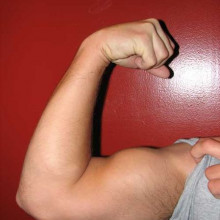
34:09 - Cracking Down on Cheating Athletes
Cracking Down on Cheating Athletes
with John Danaceau, Sports Medicine and Testing Lab, University of Utah
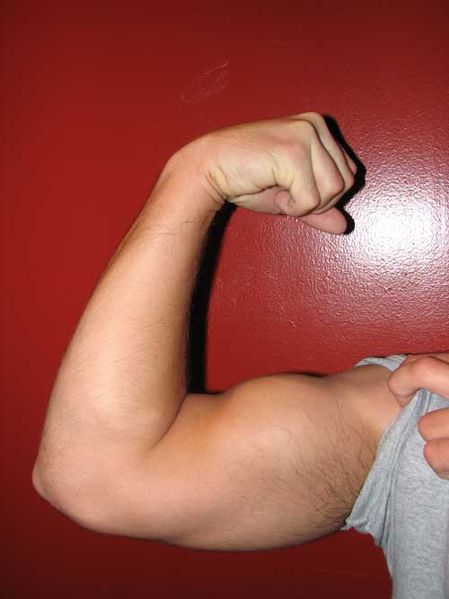 Chris - Someone who's been working on ways to detect if people are cheating is John Danaceau. He joins us from the Sports Medicine and Testing Lab at the University of Utah. Hello John.
Chris - Someone who's been working on ways to detect if people are cheating is John Danaceau. He joins us from the Sports Medicine and Testing Lab at the University of Utah. Hello John.
John - Hello, how are you?
Chris - Very well, thank you. Welcome to the Naked Scientists. What sorts of agents have you been looking at?
John - You just mentioned on the show some of the ones that are typically looked at. We test for things like anabolic steroids both natural and synthetic. We look for stimulants, we also look for masking agents which include things like diuretics which increase urine production - help people flush out their systems if they've taken something illegal. Also, for example, there's a compound called finasteride. It's included in the masking agents but it's a steroid and metabolism regulator. It decreases the production of a compound called DHT which produces some secondary side-effects of testosterone. Those are the main ones we look for. Our lab's also working on developing a method to look at homologous blood transfusions, human growth hormone and things like that. Most of what you've been talking about we're working on in our laboratory right now.
Chris - The problem is if you take a drug which is something that's naturally found in the body anyway how do you determine that person has taken it illicitly and it's not just that they've got very high levels of that anyway?
John - There's a couple of ways. For example, if you look at testosterone. You mentioned you couldn't get it from your diet but there are synthetically produced versions of testosterone. The big difference is that almost all synthetic hormones are produced from plant material. Plant material has a difference ratio of carbon-12, which is the most abundant carbon isotope, to carbon-13. It's a naturally-occurring carbon isotope. One of the ways that you can test for that is using a carbon isotope ration mass-spectrometer. It's a method we're developing right now that most other anti-doping labs in the world have up and running. We're very close to getting our up and running right now.
Chris - What if I suddenly binged on testosterone to bulk up my muscles? What could you find and tell that I'd definitely taken something from outside my body?
John - One of the things we look at for the CIR test. We take something called the testosterone to epi-testosterone ratio or the TE ratio. Epi-testosterone is an isomer of testosterone. It has the same chemical formula but it's arranged a little differently. It comes out at a different time in the mass-spectrometry system. Most people have a TE ratio of around 1:1. They have equal amounts. There have been studies shown that some people have a little higher and a little lower but the World Anti-Doping Agency has set the TE ratio at 4:1 as a cut-off. If you have four times more testosterone than epi-testosterone that raises alarm bells and we can take that sample and investigate a little further.
Chris - What would happen if I took both? You can make both and then the ratio would be normal.
John - Exactly. You can take both however there is an upper limit, a ceiling, for epi-testosterone where I believe it's 100-200ng per ml. You can't just take both because your epi-testosterone level will be high enough that will also trigger a presumptive positive finding. Again we can further investigate to see if you've taken a synthetic version of testosterone or epi, for that matter. In addition to that you get some of the metabolites of testosterone. If we see those are elevated some of the naturals like DHT - that's another way that we'll say, 'ah this sample looks a bit suspicious.' We always see a little bit of DHT but if we see a lot that could tell us they may have been taking something and further investigate.
Chris - What proportion of athletes do you think at some time in their career have probably used something?
John - I'm not sure I'm qualified to say exactly. We have positive findings around 2% of those that come through us. One of the cornerstones of our lab is the confidentiality of the athletes so I can't really say. Obviously I can't divulge what are the exact tests that we get or what are the results that we get. They are in the low, I'd say, 1-2%. If you look on the WADA's website you'll see other laboratories have a similar percentage of positive findings. I should emphasise these are the positive findings found by the laboratory. Somebody could be doping, if they're very sophisticated, at a level where they've tried to get around the system. That happened with the THG that was developed at Balco.

39:58 - Running with Sports Technology
Running with Sports Technology
with Dan Toon and Tom Waller, Loughborough University
Meera - Performance sportswear plays a major role in the sporting events of today and as a result it's a growing field of scientific research. This week I went to the sports technology institute at Loughborough University to meet sports technologists Dan Toon and Tom Waller to see what sports technology is all about. Here's Tom Waller.
Tom - Sports technology is one part of a very big machine of getting an athlete ready for race day. If you think about it there's sports scientists that will be dealing with their technique, their conditioning, their nutrition. Psychologists to help them prepare for the day. We're dealing with all of their equipment. Any inanimate object that the athlete interacts with from the footwear, the socks, the compression apparel, the training apparel, rehabilitation aids, gloves, helmet - you name it. If it's something that an athlete has to interact with to carry out the sport that they're competing in a sports technologist will have been involved in some part of that process.
Meera - So a lot of the projects you've been working on are helping our Olympians. What particular pieces of equipment have you been enhancing?
Tom - There's quite a big project going on with personalisation in footwear. Essentially what we're looking at is tuning the properties of a shoe to aid sprinting.
Meera - Why is there a need to tailor footwear specifically to athletes? Why can't they just wear the things that are available in the high street?
Dan - For an elite performing athlete it's important to personalise the mechanical properties of footwear for maximum performance. To give you a little bit more detail I've been particularly looking at the sole unit. In a sprint spike this differs significantly to standard athletic shoes. Standard athletic shoes have a sort of elastomeric or flexible sole unit whereas a sprint spike is made of a very stiff sole unit.
Meera - I can see actually, you got some samples here. The bottom is actually very solid. I didn't realise that sprinters' shoes were this hard.
Dan - What I've actually been doing is I've designed a range of different stiffnesses from really quite flexible right through to something which is incredibly stiff like you demonstrated. Then what I've had athletes doing is running in the sprint spikes and performing jumps and various different sprinting-related tasks and then measuring their performance in the different shoes such that I can quantify how their performance differs.
Meera - What's it actually doing to them to their body or their leg in order to overall make them a faster runner?
Dan - It really comes back down to simple mechanics. If we look at the ankle joint by increasing g the stiffness of the shoe what you're essentially doing is increasing the lever length about the point of application of force generation in the foot about the ankle joint itself. By making a shoe stiff you're increasing the lever length and therefore they can generate energy more efficiently.
Meera - How much of a different has it made? Have you seen a good difference in the people that have tried them?
Dan - generally speaking, when we look at a comparison with a barefoot condition by optimising the stiffness you can probably expect to double the amount of mechanical energy you can generate at the ankle. It makes a substantial difference to getting from A-to-B in a sprint run.
Meera - Tom, what makes this any better and less immoral than resorting to drugs?
Tom - We're treading a fine line. When you talk about performance-enhancement you always raise concerns. Drugs on one hand are changing the human being. They're really changing the physiological make-up of that person whereas we're bolting things onto the outside. So for example, in Dan's situation we're looking at the shoe and how we can optimise that shoe to enhance the performance of the athlete but only within the rules. What we're not doing is putting giant springs in the bottom of their feet to make them jump higher or jump longer or run faster in that way. When we're put onto this planet we're essentially naked, we're naked without any of these tools and pieces of apparel: footwear, equipment around us. All of these sports involve things that we interact with. In terms of swimming we wear hats, we wear goggles because we have to cope with the environment that we're performing in. We're making athletes more comfortable and we're helping them to perform at optimal levels.
Dan Toon and Tom Waller are based at the University of Loughborough, and are NOISEMakers - part of the EPSRC's
New Outlooks in Science and Engineering (NOISE).

44:43 - Breathing Without Lungs?
Breathing Without Lungs?
David Bickford, Associate Professor at National University of Singapore. The ecology of the animal, where it lives are extremely fast flowing streams that are clear and cold. They're coming right down off of the largest mountain in Kalimantan, where the colder water holds more oxygen than the warmer water. When it's travelling very fast the frog is able to basically run into more molecules of oxygen as it's carried in the water. Also most amphibians are able to do most of their gas exchange through their skin anyhow. The lungs in amphibia are fairly primitive and they mostly just get a little bit of oxygen through their lungs. They get rid of most of the carbon dioxide through their skin anyhow. What is probably the real kicker, the real reason these guys don't have lungs is that same very fast-flowing water could be detrimental to you if you got swept away. A good way to get swept away is to be buoyant or to float in the water. Having lungs makes you a lot more buoyant. It's kind of in the context of very fast-flowing streams that these frogs need to so everything that they do. It's easy to imagine that being a very strong selective force.
Regulating athletes' metabolism?
We put this question to Professor Chris Cooper:
It's kind of like the athlete having a biometric passport that says they're all the same level and treating them like a formula one car. Something of the sort is used in cycling and in cross-country skiing where if you have too many red blood cells you can't compete because it's assumed it's unsafe. You might have a heart attack. You're not banned. Chris Smith - In reality someone's probably just banked a unit of blood a few months ago, built their blood back up and then re-infused it before the big race to boost their oxygen capacity before the big race?
Chris Cooper - Yeah, but if you set the level low enough then they will fail. That's the trick, to set it at a fair level.
Would athletes drug each other's drinks?
We put this question to Professor Chris Cooper:
There's always claims. Ben Johnson always thought that's what happened to him. It's not clear it was. Dieter Bowman, a famous West German runner, claimed he was drugged in his toothpaste. There was some evidence that was the case. If you're running a marathon you always take your own drink and it's always sealed. You don't take drinks that are lying around, people are concerned about it.
Is high testosterone an advantage in sport?
We put this question to Professor Chris Cooper:
There are certainly some people who've claimed that. I'm reminded of this great true story about one of the Olympic 100m sprinters who failed the test John talked about - too much testosterone. In his defence he said it was his wife's birthday so he had to have sex five times the night before and that's why his testosterone was so high. He got off!
Chris Smith - In more ways than one!
Chris Cooper - Yes, anyway, yes! Chris Smith - Is that true?
Chris Cooper - The story is true. I think testosterone can vary depending on whether you're having sex or not. Not by the amount he claims. I don't think you can use it as a performance enhancing effect. It might not be a good idea the night before a race.
Drugs in our water supply?
We put this question to Professor Chris Cooper:
That's an interesting question. There's always scare stories about what's in my water, what harm is it doing? There's a long-term slight concern about female hormones getting into the water at very low levels. It's not likely to be a big health problem but there have been concerns in the past. In terms of drugs and sport there's no way you can get enough drugs for you water supply to help with sport or to fail a drugs test. The small part of that question is not a problem. The general human health point is a whole other major issue which I think is probably overstated but it is out there.
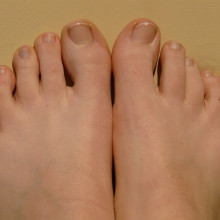
Is it faster to run barefoot?
We put this question to Professor Chris Cooper...
Clearly it is faster for you because you've just given us the scientific evidence that you feel you do run faster when you're in bare feet. I don't think in general running barefoot is faster. The historical example is Zola Budd who is South African and came to run for England. She ran as fast to begin with barefoot and she would have been much worse running in shoes because she wasn't used to running in shoes. I think your kind of event that's fine if someone doesn't step on you when you're running. The sprinting events, I think shoes are really important. I would be really surprised if you had 100m barefoot as fast as you could without.
Chris Smith - As we heard from Meera talking to the Loughborough team showing that you get far more force produced because of the ankle articulation because of the stiff shoe compared with barefoot or even a pair of trainers that are fairly soft.
Dave Ansell - Maybe he might be wearing very bad shoes, which are slowing him down?
Chris Cooper - Yes, that's another thing. Get another pair of shoes!
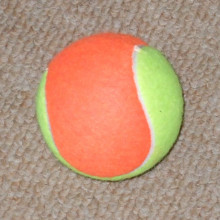





Comments
Add a comment